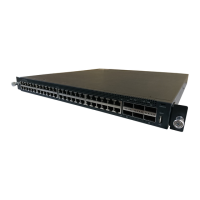FUJITSU PSWITCH User’s Guide
64 December/2018
configuration errors and makes VLAN configuration easier by reducing the amount
of commands needed for port configuration.
Administrator can configure each port to be in one of the following modes:
Access — Access ports are intended to connect end-stations to the system,
especially when the end stations are incapable of generating VLAN tags. Access
ports support a single VLAN (the PVID). Packets received untagged are processed
as if they are tagged with the access port PVID. Packets received that are tagged
with the PVID are also processed. Packets received that are tagged with a VLAN
other than the PVID are dropped.
Trunk — Trunk-mode ports are intended for switch-to-switch links. Trunk ports
can receive both tagged and untagged packets. Tagged packets received on a
trunk port are forwarded on the VLAN contained in the tag if the trunk port is a
member of the VLAN. Untagged packets received on a trunk port are forwarded
on the native VLAN. Packets received on another interface belonging to the
native VLAN are transmitted untagged on a trunk port.
General — General ports can act like access or trunk ports or a hybrid of both.
When a port is in General mode, all VLAN features are configurable. When
ingress filtering is on, the frame is dropped if the port is not a member of the
VLAN identified by the VLAN ID in the tag. If ingress filtering is off, all tagged
frames are forwarded. The port decides whether to forward or drop the frame
when the port receives the frame.
3.1.2.7.7. Protected Ports
The protected ports feature can be used to prevent ports from forwarding traffic to
each other, even if they are on the same VLAN. This feature only support on
physical port interface.
3.1.2.7.8. Double VLAN (DVLAN) Tunneling
This feature allows service providers to create Virtual Metropolitan Area Networks
(VMANs). With double-VLAN tagging, service providers can pass VLAN traffic from
one customer domain to another through a metro core in a simple and
cost-effective manner. The use of an additional tag on VLAN traffic differentiates
between customers in a Metropolitan Area Network (MAN) while preserving the
VLAN identification of the customer’s domain.
With the introduction of this second tag, the feature expands VLAN space to send
traffic. In short, every frame that is transmitted from an interface has a
double-VLAN tag attached, while every packet that is received from an interface

